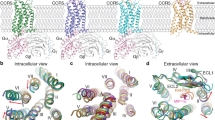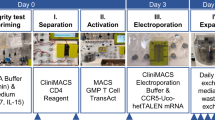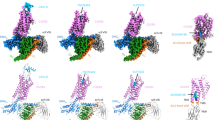Abstract
Certain chemokines act as natural antagonists of human immunodeficiency virus (HIV) by blocking key viral coreceptors, such as CCR5 and CXCR4, on the surface of susceptible cells. Elucidating the structural determinants of the receptor-binding and HIV-inhibitory functions of these chemokines is essential for the rational design of derivative molecules of therapeutic value. Here, we identify the structural determinants of CCR5 recognition and antiviral activity of the CC chemokine RANTES, showing that critical residues form a solvent-exposed hydrophobic patch on the surface of the molecule. Moreover, we demonstrate that the biological function is critically dependent on dimerization, resulting in the exposure of a large (∼180 Å2), continuous hydrophobic surface. Relevant to the development of novel therapeutic approaches, we designed a retroinverted RANTES peptide mimetic that maintained both HIV- and chemotaxis-antagonistic functions.
This is a preview of subscription content, access via your institution
Access options
Subscribe to this journal
Receive 12 print issues and online access
$259.00 per year
only $21.58 per issue
Buy this article
- Purchase on SpringerLink
- Instant access to full article PDF
Prices may be subject to local taxes which are calculated during checkout





Similar content being viewed by others
References
Baggiolini, M., Dewald, B. & Moser, B. Ann. Rev. Immunol. 55, 97–179 (1994).
Schall, T.J. & Bacon, K.B. Curr. Opin. Immunol. 6, 865–873 (1994).
Cocchi, F. et al. Science 270, 1811–1815 (1995).
Berger, E.A., Murphy, P.M. & Farber, J.M. Ann. Rev. Immunol. 17, 657–700 (1999).
Lusso, P. Virology 273, 228–240 (2000).
Skelton, N.J., Aspiras, F., Ogez, J. & Schall, T.J. Biochemistry 34, 5329–5342 (1995).
Chung, C., Cooke, R.M., Proudfoot, A.E. & Wells, T.N.C. Biochemistry 34, 9307–9314 (1995).
Siciliano, S.J. et al. Proc. Natl. Acad. Sci. USA 91, 1214–1218 (1994).
Clark-Lewis, I. et al. J. Leuk. Biol. 57, 703–711 (1995).
Gong, J.-H., Uguccioni, M., Dewald, B., Baggiolini, M. & Clark-Lewis, I. J. Biol. Chem. 271, 10521–10527 (1996).
Proudfoot, A.E. et al. J. Biol. Chem. 271, 2599–2605 (1996).
Arenzana-Seisdedos, F. et al. Nature 383, 400 (1996).
Clark-Lewis, I., Dewald, B., Loetscher, M., Moser, B. & Baggiolini, M. J. Biol. Chem. 269, 16075–16081 (1994).
Schraufstätter, I.U., Ma, M., Oades, Z.G., Barritt, D.S. & Cochrane, C.G. J. Biol. Chem. 270, 10428–10431 (1995).
Lowman, H.B. et al. J. Biol. Chem. 271, 14344–14352 (1996).
Pakianathan, D.R., Kuta, E.G., Artis, D.R., Skelton, N.J. & Hebert, C.A. Biochemistry 36, 9642–8648 (1997).
Crump, M.P. et al. EMBO J. 16, 6996–7007 (1997).
Hemmerich, S. et al. Biochemistry 38, 13013–13025 (1999).
Laurence, J.S., Blanpain, C., Burgner, J.W., Parmentier, M. & LiWang, P.J. Biochemistry 39, 3401–3409 (2000).
Cocchi, F. et al. Nature Med. 2, 1244–1247 (1996).
Farzan, M. et al. J. Biol. Chem. 272, 6854–6857 (1997).
Chorev, M. & Goodman, M. Trends Biotechnol. 13, 438–445 (1995).
Ferrer, M. et al. Nature Struct. Biol. 6, 953–960 (1999).
Romano, C., Yang, W.L. & O' Malley, K.L. J. Biol. Chem. 271, 28612–28616 (1996).
Jordan, B.A. & Devi, L.A. Nature 399, 697–700 (1999).
Mellado, M., Rodríguez-Frade, J.M., Vila-Coro, A.J., De Ana A.M. & Martínez, A.C. Nature 400, 723–724 (1999).
Ellman, G.L. Arch. Biochem. Biophys. 82, 70–77 (1959).
Polo, S., et al. Eur. J. Immunol. 30, 3190–3198, 2000.
Nichols, A.J., Sharp, K. & Honig, B. Proteins 11, 281–296 (1991).
Acknowledgements
We thank D.R. Littman for CCR5-transfected U87 cells (Ghost-CD4 cells), E.A. Berger for vaccinia virus vectors, E. Frittoli for technical assistance and S. Laus for editorial assistance. This work was supported by grants from the ISS AIDS Program, Rome, Italy.
Author information
Authors and Affiliations
Corresponding author
Rights and permissions
About this article
Cite this article
Nardese, V., Longhi, R., Polo, S. et al. Structural determinants of CCR5 recognition and HIV-1 blockade in RANTES. Nat Struct Mol Biol 8, 611–615 (2001). https://doi.org/10.1038/89653
Received:
Accepted:
Issue date:
DOI: https://doi.org/10.1038/89653
This article is cited by
-
Rational CCL5 mutagenesis integration in a lactobacilli platform generates extremely potent HIV-1 blockers
Scientific Reports (2018)
-
Protein and oligonucleotide delivery systems for vaginal microbicides against viral STIs
Cellular and Molecular Life Sciences (2015)
-
Elucidating a Key Anti-HIV-1 and Cancer-Associated Axis: The Structure of CCL5 (Rantes) in Complex with CCR5
Scientific Reports (2014)
-
Biophysical and structural investigation of bacterially expressed and engineered CCR5, a G protein-coupled receptor
Journal of Biomolecular NMR (2013)
-
Foot-and-mouth disease virus leader proteinase inhibits dsRNA-induced RANTES transcription in PK-15 cells
Virus Genes (2011)



